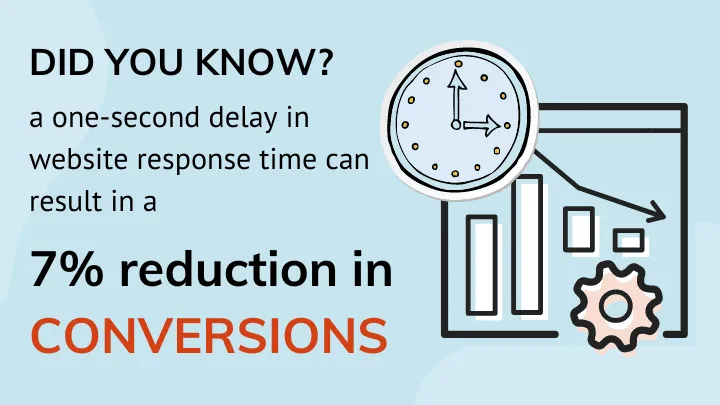

January 13, 2023
5-Step Load Testing Optimization Plan for Educational Institutions
Admissions and re-enrollment is on the horizon. Is your website optimized for peak performance?

Rich Howard
Founder & CEO
In today's fast-paced digital landscape, where a single second's delay can mean the difference between success and failure, mastering the art of load testing isn’t an option but a necessity. For major educational institutions, the stakes are even higher during critical periods like admissions season.
Our 5-Step Load Testing Plan is your gateway to not just surviving, but thriving in these high-pressure scenarios.
In this article, we’ll uncover insights and strategies that will revolutionize your approach to system performance, ensuring your operations aren’t just efficient, but exemplary.
Let’s get started…
1. Align load testing objectives with business goals
For schools, aligning technical strategies with business goals is not just prudent; it's essential. This alignment becomes critical during high-traffic events like admissions and re-enrollment, where the stakes are high, and the margin for error is slim.
Website reliability isn't just about maintaining operations; it's about upholding patient trust and ensuring seamless access to crucial services during peak times.
To do that, we recommend taking a deep dive into your unique business landscape. Analyze past peak period data, user experience feedback, and typical user journey analytics. Doing so helps you tailor load testing to simulate the real-world scenarios your site will face during enrollment.
One common pitfall many organizations encounter is failing to align their load testing objectives with key outcomes.
For instance, focusing solely on handling maximum user load without considering user experience during peak traffic can lead to suboptimal family interactions.
Avoid this by setting specific objectives, like enhancing site reliability and user experience during enrollment. Ensure that every technical effort directly contributes to delivering value to your families and students.

Another critical aspect is learning from industry benchmarks. According to a study by Akamai Technologies, a one-second delay in website response time can result in a 7% reduction in conversions.
For schools, this could significantly impact enrollment.
Hence, when we load test for companies, it’s not just about assessing capacity; it's about optimizing for peak performance, keeping in mind the end goal of sustaining and enhancing user engagement and satisfaction.
2. Gather Data from Multiple Sources to Generate User Scenarios
Effective load testing hinges on creating scenarios that accurately mimic real-world user behavior, especially during critical periods like admissions season for major schools. The key? A multi-faceted data gathering approach.
Firstly, historical data is invaluable.
By analyzing traffic and user behavior from previous high-traffic periods, you gain insights into typical user actions and pain points. This data forms the backbone of user scenarios, ensuring they reflect actual usage patterns rather than hypotheticals.
But don’t stop there.
You must incorporate direct user feedback into scenario planning. This feedback provides a qualitative dimension, highlighting issues that might not be immediately apparent from quantitative data alone.
For instance, if users report delays or errors during stages of their online journey, replicate these scenarios to test and improve those specific areas.
Another crucial element is the inclusion of various user types.
A common oversight in load testing is designing scenarios only for the 'average' user.
However, during events like admissions and re-enrollment, user behavior can vary widely. Some might be tech-savvy, navigating swiftly through the process, while others take longer, exploring different options or requiring more assistance.
Incorporating this diversity into our scenarios ensures testing covers a broad spectrum of user interactions.
Finally, we believe in the power of collaboration.
When organizations ask us to help with their load testing, we work closely with internal teams, refining scenarios to ensure they’re technically accurate and fully aligned with your operational and customer service goals.
This collaborative approach allows us to create scenarios that are not only data-driven but also deeply rooted in the reality of your operations.
Adopting a comprehensive, data-centric approach ensures that your load testing scenarios are as realistic and relevant as possible, providing you with actionable insights to optimize your systems for peak performance.
3. Identify Powerful Key Performance Metrics and Indicators
Choosing the right metrics is vital for effective load testing, where system performance can significantly impact user experience and trust during crucial times.
Here are five key metrics to analyze:
Response Time: This is perhaps the most critical metric. Even a slight delay can lead to user frustration for schools during peak periods. We focus on optimizing response times to ensure swift and smooth user interactions.
Error Rates: High error rates during peak traffic are a red flag. They not only frustrate users but also erode trust in your digital platform. Our testing rigorously checks for errors under various loads to ensure reliability.
Concurrent User Load: Understanding how your system behaves under the stress of multiple simultaneous users is essential. This metric is particularly relevant during admissions season when user traffic spikes significantly.
Resource Utilization: Monitoring CPU, memory, and network usage helps identify potential bottlenecks. Efficient resource utilization ensures the system remains stable even under heavy load.
Throughput: This metric provides insights into the number of transactions or requests handled per unit of time, giving a clear picture of the system's capacity.
Focusing on these key performance indicators helps you pinpoint areas for optimization.
For instance, if response times increase disproportionately with user load, it could indicate a need for better resource allocation or code optimization.
When working with Optimal for your load testing, our approach is to not just identify issues but to provide actionable recommendations.
For example, if error rates are high, we delve deeper to understand the underlying causes – whether it's server configuration, database issues, or something else – and then provide specific, targeted solutions
Identifying and analyzing these powerful metrics ensures your systems can handle high traffic and optimize for peak performance.
They also enhance user experience and support your business goals during critical periods.
4. Test Load Volumes in Real Time
Testing load volumes in real-time is a critical step, particularly for schools during high-traffic events.
This phase involves more than just assessing how many users your site can handle; it's about understanding how your system behaves under realistic conditions.
Simulating Real Traffic Conditions: Instead of hypothetical scenarios, replicate the specific patterns of user behavior experienced during past peak periods. This realistic simulation identifies at what points the system might falter and how it handles sudden spikes in traffic.
Gradual Increase in Load: A common mistake is to jump directly to testing at peak load, which can overlook how the system scales. Instead, incrementally increase the load, observing how the system copes at each stage. This method reveals thresholds where performance starts to degrade, offering a nuanced understanding of your system's limits.
Monitoring and Analyzing System Behavior: During these tests, keep a close eye on various system components. For instance, if a server begins to slow down at half the expected user load, this might indicate a configuration issue or a need for more efficient resource allocation. By pinpointing these specific issues, you can make targeted improvements.
Real-Time Adaptation: User behavior can be unpredictable during application and enrollment times. Be prepared for any scenario by designing your tests to mimic these variations.
This detailed and realistic approach to load testing ensures that your systems can handle high traffic volumes and are optimized for smooth and efficient operations during critical periods.
5. Generate an Easy-to-Interpret Report and Immediate Action Plan for Team and Leadership
The culmination of our load testing process isn’t solely about providing data but also translating it into actionable insights.
Clear, Concise Reporting: Synthesize complex technical data into reports that are easy for technical and non-technical stakeholders to understand. This is crucial for informed decision making.
Actionable Recommendations: Each report highlights critical areas needing attention, offering specific, actionable steps. This could range from infrastructure enhancements to code optimization tailored to your unique system needs.
Prioritization of Issues: Prioritize improvements based on their impact and urgency, focusing on crucial aspects during peak times.
Aligning with Business Goals: Align technical findings with your business objectives, ensuring that every recommendation supports your broader goals, such as enhancing the patient experience and ensuring system reliability during critical periods.
Facilitating Effective Communication: These reports serve as a tool for CTOs and team leaders to communicate effectively with other stakeholders, bridging the gap between technical findings and business strategies.
Comprehensive reports and action plans empower teams to make swift, informed decisions, ensuring your systems are optimized for performance and ready to deliver the best possible user experience during high-traffic events.
Conclusion
Our comprehensive 5-Step Load Testing Plan is meticulously designed to ensure your systems are robust and efficient, especially during critical periods like admissions season.
From aligning testing objectives with business goals to delivering clear, actionable reports, our tailored approach meets the complex needs of educational institutions. If you want to enhance your system's performance and reliability, we invite you to take the first step towards optimization.
Book a complimentary, one-hour load testing evaluation with us today, and let's ensure your systems are ready to meet–and exceed–the demands of peak traffic times.
RELATED SERVICES

Load & Capacity Testing
Simulate multi-user activity to test your site's limits and weak spots and ensure robust performance when the heat is on

Contingency Planning
Overcome issues quickly with expert advice that pinpoints precisely the right approach to any problem

Pre-Peak Optimization Work
Face flash sales and campaigns with confidence, knowing you've optimized for performance under pressure
TRUSTED BY THE BEST







Optimal is a diverse team of web performance fanatics. Led with experience and supported by a highly skilled team of experts. Working collaboratively, we're here to support you and your team in all of your web performance and optimization needs.
Quick Links
